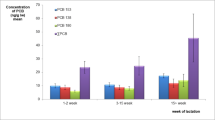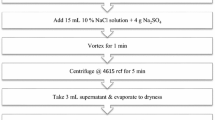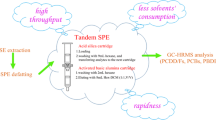Abstract
Human breast milk represents the best choice for the nutrition of infants. However, in addition to containing beneficial nutrients and antibodies, it can also be considered the best indicator of infant exposure to contaminants. We developed a multi-residue method using a modified QuEChERS (quick, easy, cheap, effective, rugged, and safe) procedure and capillary gas chromatography–triple quadrupole mass spectrometry for the determination of 57 persistent organic pollutants, including 23 organochlorine pesticides, 18 polychlorinated biphenyl (PCB) congeners, and 16 polycyclic aromatic hydrocarbons in human milk and colostrum samples. We have used primary secondary amine in the clean-up step as it gave a more efficient separation of the analytes from fat and superior removal of the co-extracted substances compared with gel permeation chromatography. No significant matrix effect was observed for the tested pollutants, and therefore matrix-matched calibration was not necessary. The average recoveries from spiked samples were in the range of 74.8–113.0 %. The precision was satisfactory, with relative standard deviations below 16 %, while values of 0.1–0.4 μg L−1 were established as the limit of quantification for all the target analytes (0.05 and 100 μg L−1). The method was successfully applied to the analysis of 18 human colostrum and 23 mature milk samples. All the samples tested were positive for at least nine different residues, with some samples containing up to 24 contaminants. Remarkably, the contaminants hexachlorobenzene, p,p’-DDE, PCB 138, PCB 180, phenanthrene, fluoranthene, and pyrene were present in 100 % of the colostrum and mature milk samples analyzed.


Similar content being viewed by others
References
Dickerson SM, Cunningham SL, Patisaul HB, Woller MJ, Gore AC (2011) Endocrine disruption of brain sexual differentiation by developmental PCB exposure. Endocrinology 152(2):581–594. doi:10.1210/en.2010-1103
Mezzetta S, Cirlini M, Ceron P, Tecleanu A, Caligiani A, Palla G, Sansebastiano GE (2011) Concentration of DL-PCBs in fish from market of Parma city (north Italy): estimated human intake. Chemosphere 82(9):1293–1300. doi:10.1016/j.chemosphere.2010.12.028
Marti-Cid R, Bocio A, Llobet JM, Domingo JL (2007) Intake of chemical contaminants through fish and seafood consumption by children of Catalonia, Spain: health risks. Food Chem Toxicol Int J Published for the British Industrial Biological Research Association 45(10):1968–1974. doi:10.1016/j.fct.2007.04.014
Almeida-Gonzalez M, Luzardo OP, Zumbado M, Rodriguez-Hernandez A, Ruiz-Suarez N, Sangil M, Camacho M, Henriquez-Hernandez LA, Boada LD (2012) Levels of organochlorine contaminants in organic and conventional cheeses and their impact on the health of consumers: an independent study in the Canary Islands (Spain). Food Chem Toxicol Int J Published for the British Industrial Biological Research Association 50(12):4325–4332. doi:10.1016/j.fct.2012.08.058
Luzardo OP, Almeida-Gonzalez M, Henriquez-Hernandez LA, Zumbado M, Alvarez-Leon EE, Boada LD (2012) Polychlorobiphenyls and organochlorine pesticides in conventional and organic brands of milk: occurrence and dietary intake in the population of the Canary Islands (Spain). Chemosphere 88(3):307–315. doi:10.1016/j.chemosphere.2012.03.002
Parks CG, Walitt BT, Pettinger M, Chen JC, de Roos AJ, Hunt J, Sarto G, Howard BV (2011) Insecticide use and risk of rheumatoid arthritis and systemic lupus erythematosus in the Women’s Health Initiative Observational Study. Arthritis Care Res (Hoboken) 63(2):184–194. doi:10.1002/acr.20335
Dorgan JF, Brock JW, Rothman N, Needham LL, Miller R, Stephenson HE Jr, Schussler N, Taylor PR (1999) Serum organochlorine pesticides and PCBs and breast cancer risk: results from a prospective analysis (USA). Cancer Causes Control 10(1):1–11
Casals-Casas C, Desvergne B (2011) Endocrine disruptors: from endocrine to metabolic disruption. Annu Rev Physiol 73:135–162. doi:10.1146/annurev-physiol-012110-142200
Boada LD, Zumbado M, Henriquez-Hernandez LA, Almeida-Gonzalez M, Alvarez-Leon EE, Serra-Majem L, Luzardo OP (2012) Complex organochlorine pesticide mixtures as determinant factor for breast cancer risk: a population-based case–control study in the Canary Islands (Spain). Environ Health 11:28. doi:10.1186/1476-069X-11-28
Schecter A, Colacino J, Haffner D, Patel K, Opel M, Papke O, Birnbaum L (2010) Perfluorinated compounds, polychlorinated biphenyls, and organochlorine pesticide contamination in composite food samples from Dallas, Texas, USA. Environ Health Perspect 118(6):796–802. doi:10.1289/ehp.0901347
Henriquez-Hernandez LA, Luzardo OP, Almeida-Gonzalez M, Alvarez-Leon EE, Serra-Majem L, Zumbado M, Boada LD (2011) Background levels of polychlorinated biphenyls in the population of the Canary Islands (Spain). Environ Res 111(1):10–16. doi:10.1016/j.envres.2010.11.005
Ribas-Fito N, Sala M, Kogevinas M, Sunyer J (2001) Polychlorinated biphenyls (PCBs) and neurological development in children: a systematic review. J Epidemiol Community Health 55(8):537–546
Murphy LE, Gollenberg AL, Buck Louis GM, Kostyniak PJ, Sundaram R (2010) Maternal serum preconception polychlorinated biphenyl concentrations and infant birth weight. Environ Health Perspect 118(2):297–302. doi:10.1289/ehp.0901150
Stewart PW, Lonky E, Reihman J, Pagano J, Gump BB, Darvill T (2008) The relationship between prenatal PCB exposure and intelligence (IQ) in 9-year-old children. Environ Health Perspect 116(10):1416–1422. doi:10.1289/ehp.11058
Park HY, Hertz-Picciotto I, Sovcikova E, Kocan A, Drobna B, Trnovec T (2010) Neurodevelopmental toxicity of prenatal polychlorinated biphenyls (PCBs) by chemical structure and activity: a birth cohort study. Environ Health 9:51. doi:10.1186/1476-069X-9-51
Knerr S, Schrenk D (2006) Carcinogenicity of "non-dioxinlike" polychlorinated biphenyls. Crit Rev Toxicol 36(9):663–694. doi:10.1080/10408440600845304
Webster L, Russell M, Walsham P, Phillips LA, Hussy I, Packer G, Dalgarno EJ, Moffat CF (2011) An assessment of persistent organic pollutants in Scottish coastal and offshore marine environments. J Environ Monit 13(5):1288–1307. doi:10.1039/c1em10100e
Roscales JL, Gonzalez-Solis J, Calabuig P, Jimenez B (2011) Interspecies and spatial trends in polycyclic aromatic hydrocarbons (PAHs) in Atlantic and Mediterranean pelagic seabirds. Environ Pollut 159(10):2899–2905. doi:10.1016/j.envpol.2011.04.034
Camacho M, Boada LD, Oros J, Calabuig P, Zumbado M, Luzardo OP (2012) Comparative study of polycyclic aromatic hydrocarbons (PAHs) in plasma of Eastern Atlantic juvenile and adult nesting loggerhead sea turtles (Caretta caretta). Mar Pollut Bull 64(9):1974–1980. doi:10.1016/j.marpolbul.2012.06.002
Cok I, Mazmanci B, Mazmanci MA, Turgut C, Henkelmann B, Schramm KW (2012) Analysis of human milk to assess exposure to PAHs, PCBs and organochlorine pesticides in the vicinity Mediterranean city Mersin, Turkey. Environ Int 40:63–69. doi:10.1016/j.envint.2011.11.012
Samanta SK, Singh OV, Jain RK (2002) Polycyclic aromatic hydrocarbons: environmental pollution and bioremediation. Trends Biotechnol 20(6):243–248
Brody JG, Moysich KB, Humblet O, Attfield KR, Beehler GP, Rudel RA (2007) Environmental pollutants and breast cancer: epidemiologic studies. Cancer 109(12 Suppl):2667–2711. doi:10.1002/cncr.22655
Wang DC, Yu P, Zhang Y, Cui Y, Sun CH (2008) The determination of persistent organic pollutants (POPs) in the colostrums of women in preterm labor. Clin Chim Acta 397(1–2):18–21. doi:10.1016/j.cca.2008.07.004
Bergkvist C, Aune M, Nilsson I, Sandanger TM, Hamadani JD, Tofail F, Oyvind-Odland J, Kabir I, Vahter M (2012) Occurrence and levels of organochlorine compounds in human breast milk in Bangladesh. Chemosphere 88(7):784–790. doi:10.1016/j.chemosphere.2012.03.083
Jakobsson K, Fang J, Athanasiadou M, Rignell-Hydbom A, Bergman A (2012) Polybrominated diphenyl ethers in maternal serum, umbilical cord serum, colostrum and mature breast milk. Insights from a pilot study and the literature. Environ Int 47:121–130. doi:10.1016/j.envint.2012.05.006
Uemura H, Arisawa K, Hiyoshi M, Satoh H, Sumiyoshi Y, Morinaga K, Kodama K, Suzuki T, Nagai M, Suzuki T (2008) PCDDs/PCDFs and dioxin-like PCBs: recent body burden levels and their determinants among general inhabitants in Japan. Chemosphere 73(1):30–37. doi:10.1016/j.chemosphere.2008.05.066
Kim SR, Halden RU, Buckley TJ (2008) Polycyclic aromatic hydrocarbons in human milk of nonsmoking U.S. women. Environ Sci Technol 42(7):2663–2667
Luzardo OP, Mahtani V, Troyano JM, Alvarez de la Rosa M, Padilla-Perez AI, Zumbado M, Almeida M, Burillo-Putze G, Boada C, Boada LD (2009) Determinants of organochlorine levels detectable in the amniotic fluid of women from Tenerife Island (Canary Islands, Spain). Environ Res 109(5):607–613. doi:10.1016/j.envres.2009.03.008
Esteban M, Castano A (2009) Non-invasive matrices in human biomonitoring: a review. Environ Int 35(2):438–449. doi:10.1016/j.envint.2008.09.003
Castillo M, Gonzalez C, Miralles A (2011) An evaluation method for determination of non-polar pesticide residues in animal fat samples by using dispersive solid-phase extraction clean-up and GC-MS. Anal Bioanal Chem 400(5):1315–1328. doi:10.1007/s00216-011-4656-5
Smoker M, Tran K, Smith RE (2010) Determination of polycyclic aromatic hydrocarbons (PAHs) in shrimp. J Agric Food Chem. doi:10.1021/jf1029652
Clarke L, Moloney M, O’Mahony J, O’Kennedy R, Danaher M (2013) Determination of 20 coccidiostats in milk, duck muscle and non-avian muscle tissue using UHPLC-MS/MS. Food Addit Contam Part A Chem Anal Control Expo Risk Assess 30(6):958–969. doi:10.1080/19440049.2013.794306
Li N, Lei L, Nian L, Zhang R, Wu S, Ren R, Wang Y, Zhang H, Yu A (2013) A modified QuEChERS method for the determination of some herbicides in yogurt and milk by high performance liquid chromatography. Talanta 105:219–228. doi:10.1016/j.talanta.2012.11.057
Parab SR, Amritkar PN (2012) Development and validation of a procedure for determination of sulfonamide residues in pasteurized milk using modified QuEChERS method and liquid chromatography/tandem mass spectrometry. J AOAC Int 95(5):1528–1533
Jeong IS, Kwak BM, Ahn JH, Jeong SH (2012) Determination of pesticide residues in milk using a QuEChERS-based method developed by response surface methodology. Chemosphere 133(2):473–481
Walorczyk S (2008) Development of a multi-residue method for the determination of pesticides in cereals and dry animal feed using gas chromatography-tandem quadrupole mass spectrometry II. Improvement and extension to new analytes. J Chromatogr A 1208(1–2):202–214. doi:10.1016/j.chroma.2008.08.068
Burke ER, Holden AJ, Shaw IC (2003) A method to determine residue levels of persistent organochlorine pesticides in human milk from Indonesian women. Chemosphere 50(4):529–535
Liao C, Yang P, Xie Z, Zhao Y, Cheng X, Zhang Y, Ren Z, Guo Z, Liao J (2010) Application of GC-triple quadrupole MS in the quantitative confirmation of polycyclic aromatic hydrocarbons and phthalic acid esters in soil. J Chromatogr Sci 48(3):161–166
Rashid A, Nawaz S, Barker H, Ahmad I, Ashraf M (2010) Development of a simple extraction and clean-up procedure for determination of organochlorine pesticides in soil using gas chromatography-tandem mass spectrometry. J Chromatogr A 1217(17):2933–2939. doi:10.1016/j.chroma.2010.02.060
Walorczyk S (2007) Development of a multi-residue screening method for the determination of pesticides in cereals and dry animal feed using gas chromatography-triple quadrupole tandem mass spectrometry. J Chromatogr A 1165(1–2):200–212. doi:10.1016/j.chroma.2007.07.071
2002/657/EC Comission Decission Implementing Council Directive Nº 96/23/CE of August 12. Off J Eur Union
Anastassiades M, Lehotay SJ, Stajnbaher D, Schenck FJ (2003) Fast and easy multiresidue method employing acetonitrile extraction/partitioning and "dispersive solid-phase extraction" for the determination of pesticide residues in produce. J AOAC Int 86(2):412–431
Lehotay SJ, Son KA, Kwon H, Koesukwiwat U, Fu W, Mastovska K, Hoh E, Leepipatpiboon N (2010) Comparison of QuEChERS sample preparation methods for the analysis of pesticide residues in fruits and vegetables. J Chromatogr A 1217(16):2548–2560. doi:10.1016/j.chroma.2010.01.044
Lazartigues A, Wiest L, Baudot R, Thomas M, Feidt C, Cren-Olive C (2011) Multiresidue method to quantify pesticides in fish muscle by QuEChERS-based extraction and LC-MS/MS. Anal Bioanal Chem 400(7):2185–2193. doi:10.1007/s00216-011-4945-z
Selvi C, Paramasivam M, Rajathi DS, Chandrasekaran S (2012) Multiresidue analysis of organochlorine pesticides in milk, egg and meat by GC-ECD and confirmation by GC-MS. Bull Environ Contam Toxicol 89(5):1051–1056. doi:10.1007/s00128-012-0789-2
Acknowledgments
The authors would like to thank the human milk and colostrum sample providers, Dr. Lluis Serra Majem and Dr. Adriana Ortiz Andrelluchi from the Nutrition Research Group of the University of Las Palmas de Gran Canaria and Mrs. María de los Reyes Suárez Hanna for her for her technical assistance.
Author information
Authors and Affiliations
Corresponding author
Electronic supplementary material
Below is the link to the electronic supplementary material.
ESM 1
(PDF 88.4 kb)
Rights and permissions
About this article
Cite this article
Luzardo, O.P., Ruiz-Suárez, N., Almeida-González, M. et al. Multi-residue method for the determination of 57 Persistent Organic Pollutants in human milk and colostrum using a QuEChERS-based extraction procedure. Anal Bioanal Chem 405, 9523–9536 (2013). https://doi.org/10.1007/s00216-013-7377-0
Received:
Revised:
Accepted:
Published:
Issue Date:
DOI: https://doi.org/10.1007/s00216-013-7377-0




